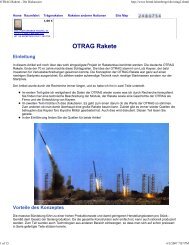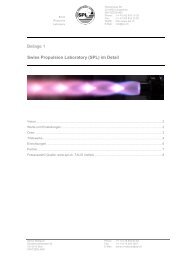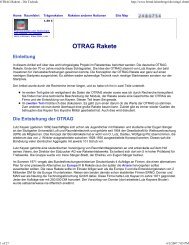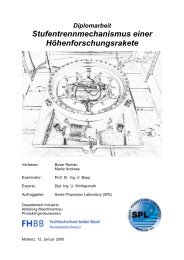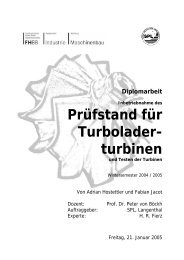Create successful ePaper yourself
Turn your PDF publications into a flip-book with our unique Google optimized e-Paper software.
Thrust during lifting 3.00 tonnes<br />
Burn after 32.00 sec<br />
Burn out at 3.00 mach<br />
Total flight time 3.00 min<br />
Impact after 50 - 70 km<br />
After an internal dispute Lutz Kayser left <strong>OTRAG</strong> 1982. On 10/04/1982 reported<br />
Aviation Week & technology that is now trying <strong>OTRAG</strong> under the sole direction of<br />
Frank Wukasch her troubled relationship with the German government to clean up and is<br />
now focused on the development of sounding rockets as an intermediate for the orbital<br />
version. A single module can bring in 50 200 kg or 30 kg km altitude in 90 km altitude. A<br />
two-stage version with 6 modules and a first module, the second stage is 500 kg in 280<br />
km height or 50 kg bring in 655 km altitude. Wukasch acted smarter than Kayser. As<br />
mentioned, the Soviet propaganda made against the company and even some U.S. media<br />
participated in it (In March 1978, Ted Szulc-shifting in the men's magazine "Penthouse",<br />
which was developing a <strong>OTRAG</strong> "V3" from other African countries). Of course this led<br />
to reactions from the German government. Kayser reported each wanted to know (or not)<br />
as he was being followed by the German government, rather than the posts directly to<br />
write to find a solution beyond the public). Frank Wukasch knew that a confrontation was<br />
futile for such a small company and changed the company policy - First of all<br />
cooperation with Germany by the <strong>OTRAG</strong> offered as a sounding rocket - so do not<br />
compete with Ariane. The following options were provided:<br />
1-6-P 3-9-9-P 4-P 3-6-P 2 4-6-6-9-P2 P2<br />
Module level 1 1 3 4 3 4 6<br />
Module Level 2 - - - 1 1 1<br />
Total length 9.4 m 14.1 m 14.1 m 4.4 m 15.1 m 14.4 M<br />
Diameter 0:27 m 0.58 m 0.64 m 00:58 / 0.27 m 0.64 / 0.27 0.98 m / 0.27 m<br />
Payload length 1.4 m 3.1 m 3.1 m 1.4 m 1.4 m 4.0 m<br />
like cylindrical 0.5 m 1.1 m 1.1 m 0.5 m 0.5 m 1.5 m<br />
this peak 0.9 m 2.0 m 2.0 m 0.9 m 0.9 m 0.9 m<br />
Diameter 0.64 m 0.64 m Payload 00:27 m 00:27 m 12:27 m 0.98 m<br />
Maximum payload weight: 200 kg 250 kg 300 kg 250 kg 350 kg 500 kg<br />
No text but it was too late for a turnaround. The program then trickled out slowly, mainly<br />
because there were problems within Germany. The tax authorities and the Federal<br />
Financial Court said the <strong>OTRAG</strong> from the profit. Thus, the <strong>OTRAG</strong> had become less<br />
attractive for investors, for now fell off the write-offs, had alienated If the move to Libya<br />
to investors not previously, the <strong>OTRAG</strong> was now in any case not more new money. The<br />
technical development was halted.<br />
There was still a start, led by Frank Wukasch at ESA in Kiruna (Norway) in 1983. This<br />
was successful, and started experiments and the RWTH University of Munich. However,<br />
the parachute opened and so was not the instrument capsule lost. Kayser's company was<br />
liquidated in 1986 by the shareholders.<br />
Until then, the carrier rocket development swallowed up 150 million marks, of which



